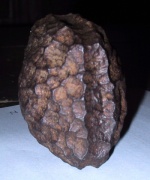
Wolfsegg Iron
This article needs additional citations for verification. (September 2014) |

The Wolfsegg Iron, also known as the Salzburg Cube, is a small cuboid mass of iron that was found buried in Tertiary lignite in Wolfsegg am Hausruck, Austria, in 1885.[1] It weighs 785 grams (1 lb 12 oz) and measures 67 mm × 67 mm × 47 mm (2¾" x 2¾" x 1¾"). Four of its sides are roughly flat, while the two remaining sides (opposite each other) are convex. A fairly deep groove is incised all the way around the object, about mid-way up its height.[2][3]

The Wolfsegg Iron became notable when it was claimed to be an out-of-place artifact: a worked iron cube found buried in a 20-million-year-old coal seam. It was originally identified by scientists as being of meteoric origin,[2] a suggestion later ruled out by analysis.[citation needed] It seems most likely that it is a piece of cast iron used as ballast in mining machinery, deposited during mining efforts before it was found apparently within the seam.[citation needed]

History
Early descriptions of the object appeared in contemporary editions of the scientific journals Nature and L'Astronomie, the object identified by scientists as being a fossil meteorite. It was reported that the object was discovered when a workman at the Braun iron foundry in Schöndorf, Austria, was breaking up a block of lignite that had been mined at Wolfsegg. In 1886, mining engineer Adolf Gurlt reported on the object to the Natural History Society of Bonn, noting that the object was coated with a thin layer of rust, was made of iron, and had a specific gravity of 7.75.[2][3]

A plaster cast was made of the object shortly before the end of the 19th century, as the original had suffered from being handled, and had had samples cut from it by researchers.[citation needed]

Analysis
The object was analysed in 1966–1967 by the Vienna Naturhistorisches Museum using electron beam micro-analysis,[citation needed] which found no traces of nickel, chromium or cobalt in the iron, suggesting that it was not of meteoric origin, while the lack of sulfur indicated that it is not a pyrite.[citation needed] Because of its low magnesium content, Dr. Gero Kurat of the museum and Dr. Rudolf Grill of the Federal Geological Office in Vienna thought that it might be cast iron, Grill suggesting that similar rough lumps had been used as ballast in early mining machinery.[citation needed]

The cast is currently kept in the Oberösterreichischen Landesmuseen in Linz, Austria, where the original object was also exhibited from 1950 to 1958,[citation needed] while the original cuboid is held by the Heimathaus Museum of Vöcklabruck, Austria.[citation needed]

Out-of-place artifact
The Wolfsegg Iron is claimed by some as an out-of-place artifact (OOPArt), and it is often stated as a fact in paranormal literature that it disappeared without trace in 1910, from the Salzburg Museum.[4][5] In fact, as mentioned, it is at the Heimathaus Museum in Vöcklabruck, Austria, which is where the photo was taken. It has also erroneously been described as "a perfectly machined steel cube".[6]

Notes
- ^ Grady, Monica M.; A. L. Graham (2000). Catalogue of Meteorites: with special reference to those represented in the collection of the Natural History Museum, London. Cambridge University Press. p. 529. ISBN 0-521-66303-2.
- ^ a b c "Notes". Nature. 35 (889): 36. 11 November 1886. Bibcode:1886Natur..35...34.. doi:10.1038/035034a0.
- ^ a b "Uranolithe fossile" [Uranolithic fossil]. L'Astronomie (in French). 10 (7): 114. 1888.
- ^ Noorbergen, Rene (2001). Secrets of the Lost Races: New Discoveries of Advanced Technology in Ancient Civilizations. TEACH Services, Inc. p. 43. ISBN 1-57258-198-0.
- ^ Short, Robert (2003). Out of the Stars. Buy Books. p. 69. ISBN 0-7414-1504-6.
- ^ Sagan, Carl; Jerome Agel (2000). Carl Sagan's Cosmic Connection. Cambridge University Press. p. 206. ISBN 0-521-78303-8.
See what we do next...
OR
By submitting your email or phone number, you're giving mschf permission to send you email and/or recurring marketing texts. Data rates may apply. Text stop to cancel, help for help.
Success: You're subscribed now !
